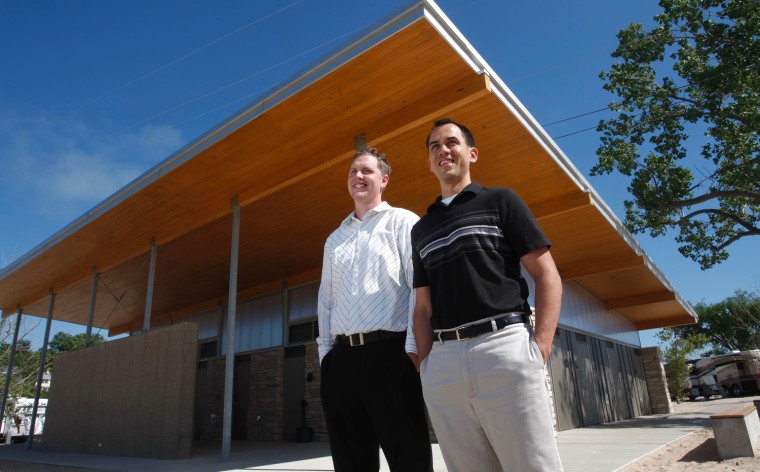There's a lot about Clay's Park Resort that appeals to Janet Durtschi, including its ongoing effort to get "greener."
She and her husband, Donald, have bought seasonal memberships to the northeastern Ohio campground for the past seven years. When there, she enjoys playing miniature golf, dining at Ralphie's restaurant and cruising in a golf cart to look at wildflowers.
He spends much of his time at the indoor swimming pool, where the park is installing solar panels to help heat the water and changing the sanitization system from chlorine to saline. Before last winter, the resort replaced the propane heating system in its administrative offices with a wood-burning stove fueled by the park's lawn and tree clippings.
"These are things that I feel are very good for the environment," says Janet Durtschi, 57, of Wooster, Ohio.
Other resorts are making similar investments aimed at saving water and energy, with the encouragement of the National Association of RV Parks and Campgrounds. The Larkspur, Colo.-based trade association, which represents more than 8,000 private campgrounds and parks for recreational vehicles in the United States, launched a green-parks initiative two years ago called "Plan It Green."
"A lot of parks were already doing things that helped the environment and I think a lot more of them are embracing the concept," says Linda Profaizer, the group's president and chief executive.
In southwestern Michigan, Sandy Pines, one of the nation's largest RV resorts, is putting in solar panels that will warm up the water used at two of its heated swimming pools. The resort, which is about 25 miles south-southwest of Grand Rapids, also is putting in a geothermal heating and cooling system at a building that houses a country store, coin-operated laundry and coffee shop.
"The cost savings is tremendous," says Max Gibbs, park director. He estimates that it will take about three years for the resort to recover its $32,000 expense for the solar panels and eight to 10 years to get back its $72,000 cost for the geothermal system.
While gray skies dominate the coldest months of the year, Michigan gets a lot of sunshine during the summer. Using arrays of solar panels instead of costly fossil fuels to heat pools "can easily extend the swimming season in Michigan by two months," says Chuck Ammond, director of engineering for Bauer Power Inc.
The Martin-based company is installing the photovoltaic systems for the two pools at Sandy Pines, which is in Allegan County's Hopkins Township. The resort features more than 800 acres of lake and woodland, an 18-hole golf course and more than 2,200 campsites.
Like Clay's, Sandy Pines is changing the way it sanitizes its two swimming pools, switching from chlorine to saline. The conversion will cost about $7,800 but, because salt is much less expensive, could pay for itself over a single summer.
A salt-water system uses a process to create its own chlorine gas that dissolves into and sanitizes the water while preventing the formation of chlorine compounds that are found in regular pool chlorine and generate strong, objectionable odors.
"We see ourselves as a 500-acre sacred space and we want to do things correctly," says Margie Centrone, a spokeswoman for Clay's, which is near North Lawrence, Ohio, about 20 miles southwest of Akron. "We want to try to avoid any harsh chemicals that would affect nature or human beings."

The RV association's research indicates that consumers enjoy visiting campsites "that are environmentally friendly, so there's an economic incentive for parks to get involved in green initiatives beyond the savings they recoup from their investments," Profaizer says.
As part of its initiative, the group has started annually honoring resorts that demonstrate exemplary green practices. Last year's winner was the Grand Haven Resort in Kimbolton, Ohio, about 75 miles east of Columbus.
Grand Haven has undertaken various green initiatives for more than a decade, including the installation of geothermal heating and cooling systems for its front desk and fitness center and the water in an adjacent outdoor pool. Annual heating costs for the 2,880-square-foot building have plummeted 90 percent, from more than $12,000 to just over $1,200.
Recycling, composting and conservation have been staples of the operation of Cooperstown Beaver Valley Cabins & Campsites since 1988, when Juli and Dwaine Sharratt bought the 300-acre resort, which is five miles from Cooperstown, N.Y.
"We feel responsible for the environment and for our park," says Juli Sharratt.
The fence around the park's baseball field was obtained from a Connecticut college that was going to throw it away. The field's bleachers are from a dismantled baseball complex in Richfield, Minn., where Dwaine Sharratt grew up.
Materials from a stage used at a music festival were used to build the decks of the park's camping cabins. Manure is spread in place of chemical fertilizers. The resort now uses energy-efficient compact fluorescent light bulbs instead of traditional incandescent bulbs that use more electricity.
To save postage, paper and time, reservations are now confirmed by e-mail instead of regular mail whenever possible. Out of approximately 4,000 confirmations sent out since October, only two or three were mailed the old-fashioned way, Juli Sharratt says.
Campsite operators must keep finding new ways to save money through increased energy efficiency, says Mark Shambaugh, general manager of the Grand Haven resort.
"We really need to continue to look forward," he says.
